You might suspect that The Legend of Zelda: Tri Force Heroes is skippable, an inessential spinoff that is more time-killer than legendary adventure. You would be… correct.
The newest Zelda, out now for 3DS, is an unnecessary, forgettable instalment in a series that usually maintains way higher standards. Even compared to other weak Zeldas like the clunky Spirit Tracks, Tri Force Heroes is disappointing. While the game can be good and even great under the right conditions, those conditions are so rare — and so hampered by Nintendo’s inadequate online tools — that Tri Force Heroes lands with a resounding thud. I don’t recommend it.
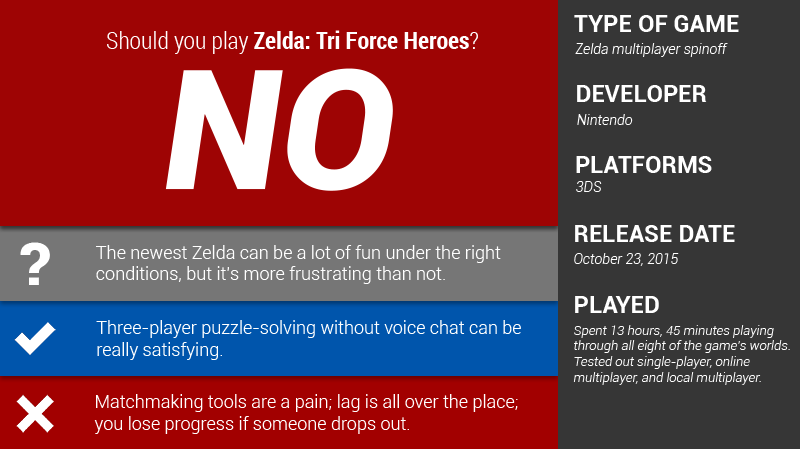
Tri Force Heroes, like Nintendo’s 2004 experiment Zelda: Four Swords Adventures, is a multiplayer spinoff designed to be played not by a single adventurer but by a group of likeminded puzzle-solvers who work together to overcome obstacles and kill monsters. There’s a plot reason for this: The king of some kingdom (uh, “Hytopia”) has gathered a bunch of heroes to save his princess from a curse that makes her look dull, and as it turns out, those heroes can only fight evil by travelling in groups of three.
Rather than guide you through the swamps and mountains of Hyrule on an epic adventure to save the world, Tri Force Heroes places you in a single town and asks you to go out on a series of missions set in familiar locales (a desert area, a water area, and so forth). There are eight maps, each with four different levels. Each of those levels has four short stages, often ending with a boss battle, and three items — one for each Link. One level might require three boomerangs; another might give you bombs, arrows, and a hookshot, then let you figure out the rest. Each player can also put on a costume that will grant buffs or boost item abilities — one, for example, makes your bombs bigger. Another grants you sword beams when you’re at full health.
The game both looks and feels like 2013’s Link Between Worlds, with one new key mechanic: Totems. Your party can stack up and form totems of two or three people, which is required to solve many of the game’s height-oriented puzzles. Team members can also pick up and throw one another, which is useful both for accessing new areas and hurling your friends over cliffs.
There are a few different ways to play through Tri Force Heroes. If you choose to play the game by yourself — which I don’t recommend — you’ll be joined by two mindless puppets that you can control at will. You’ll have to manoeuvre and move all three Links on your own, which can get tedious and at times really frustrating when you run into a puzzle or boss that requires precise three-way coordination. Moldorm, for example, is a big worm that will follow around whichever player hit him last, exposing his big ol’ tail for the other two heroes to smack. If you’re playing solo, you’re meant to lure him with one hero and then switch to another so you can hit him. But as soon as you make the swap, he’ll quickly pivot to follow around the Link you’re controlling, leaving you with very little time to get an attack off. It’s quite annoying. The game is clearly designed for three humans.
If you do want to go the multiplayer route, you can either play locally with two buddies or hop online to play with friends and randoms. I tested out all three options. Playing locally is the least practical but most fun. Playing online can be unreliable thanks to frequent lag spikes and bad players. (All three Links share the same pool of health, so a single weak hero will get you killed pretty fast.)
The only way to communicate with your party members — outside of using an external tool like Skype — is by pressing one of eight emotes on the bottom screen. You can signal that you want to form a totem or that you want someone to use an item. You can cheer and pout and scream “NOOO!” in the most adorable way possible.
Sure enough, using these emotes properly can lead to some remarkable results. My most satisfying session with Tri Force Heroes actually happened with two random players online. They really got it — they knew exactly when to stack up and when to use items; they knew to let me take the Bow because I was wearing a costume that would let me shoot out multiple arrows at once; they knew when to stop and get hearts because we were all running low.
Sometimes, when everything works just right in Tri Force Heroes, you can run into a moment like this, where everyone pulls off a tricky puzzle and cheers in unison, and it is awesome.
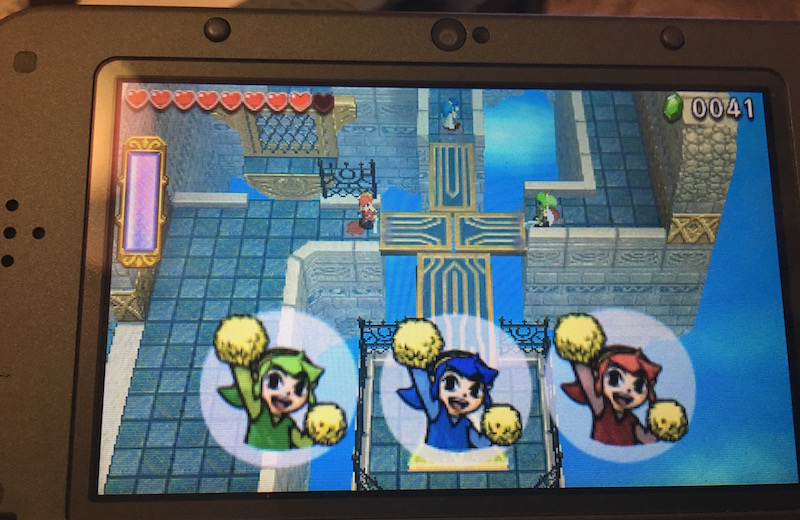
More often, though, I found myself facing this screen:
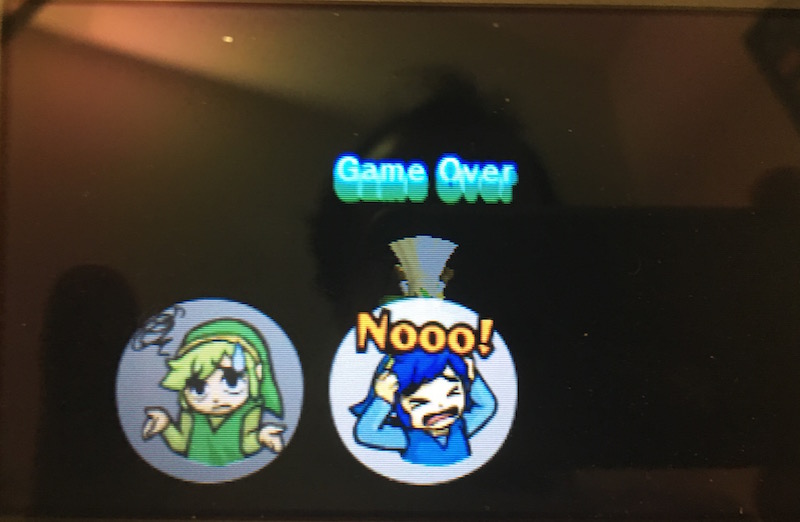
Lag spikes would fling me off ledges. Players would refuse to move or would use their items at incorrect times. One time, after a couple of rough deaths, the red Link in my party of randoms decided that he’d just jump off a cliff over and over until we got a game over.
Sometimes, at the worst possible times (say, just after completing a tricky puzzle), I’d see a symbol like this:
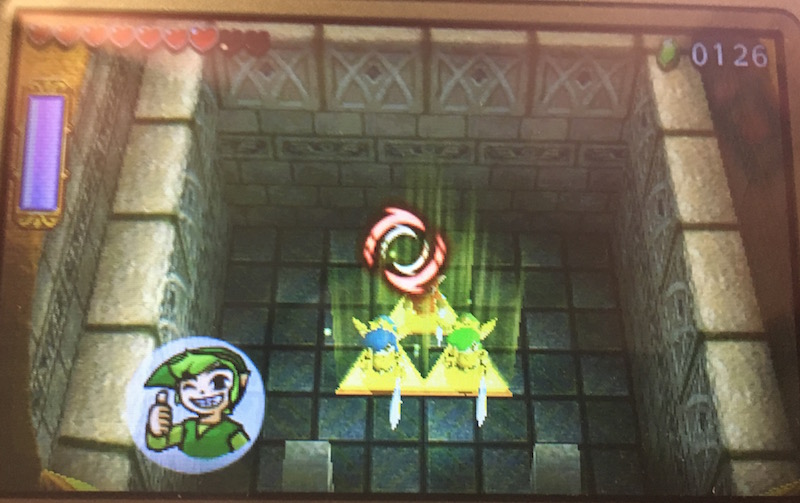
Which would then lead to this:
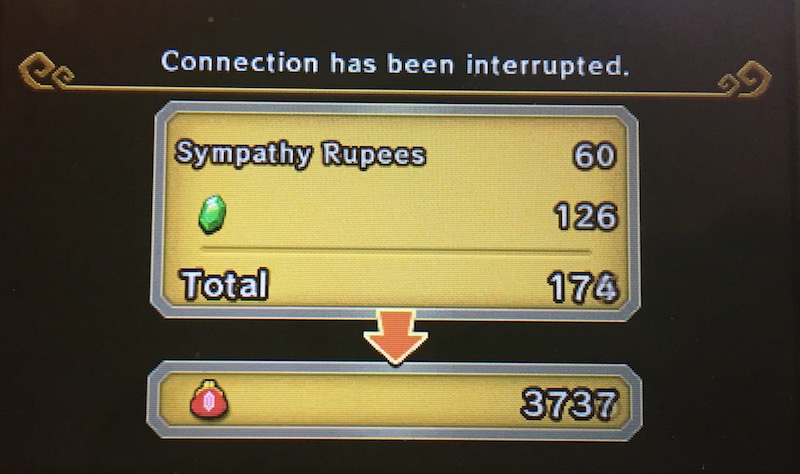
WELL HEY, AT LEAST I GOT 60 RUPEES.
It’s really too bad. Many of these unavoidable issues — lag, disconnects, bad teammates, etc. — are exacerbated by some baffling design decisions that I will list out here:
- When someone quits or is disconnected from a game, the entire party will get booted, no matter how much progress they have made. All it takes is one bad connection for you to have lost 10-15 minutes of your life.
- But hey, at least you’ll get sympathy rupees.
- Before each game session, you and your teammates will have to select a level. If there’s no consensus, this will be decided by a roulette that spins among the levels everyone picked, meaning you’ll have 1/3 chance of getting the level you want. (If one other person picked the same level but a third picked something else, you’ll have a 2/3 shot.)
- Same thing with bonus challenges — these are modifiers that might task you with completing a level in the dark or under a short time limit.
- To play with people you know but are not already 3DS friends with, you have to swap 3DS Friend Codes. Nintendo!
- When you’re playing with strangers, you’ll get to pick a map before you vote on a level — so you don’t have to worry about getting randomly stuck in the Volcano if all you want to do is play Fortress. But if you’re playing with people you know, you’ll have to go through that roulette system for both maps AND levels. Worst of all, players who haven’t unlocked a map can’t actually vote on it.
- So let’s say I want to play on the Fortress with two friends who have only gotten up to the Woodlands. I’ll vote on the Fortress, but they will be stuck voting for the Woodlands, and we’ll have a 1/3 chance of getting the map we want. If we don’t hit it, we have to quit out at the beginning of the level and start again.
- There is no way to play with only two people. This is extremely frustrating. If you want to group up with your boyfriend or roommate, you’ll have to play online and find a third person to match up with. Let it never be said that Nintendo does not encourage threesomes.
- Once you’ve started the matchmaking process, there’s no way to back out. This is understandable, I guess, but also irritating.
All these factors lead to a game that seems to be trying its hardest to be unaccommodating. When it works, it works well! But most of the time it does not work. Most of the time it’s not worth the hassle.
At its best, Tri Force Heroes is a gratifying exercise in cooperation, a game that lets you meticulously solve puzzles with two friends or strangers using nothing but your combined brainpower — and emoticons. There’s something that feels just right about figuring out, as a group, that the red Link has to pick up the green Link who has to throw a bomb that the blue Link grabs with a hookshot and throws at a switch in order to open a path and let you all through. But when you’re playing Tri Force Heroes online, you’re usually not figuring this out. Too often, you’ll be struggling just to get the match you want.
If you’ve got three 3DSes and two other roommates, family members, or significant others, then Tri Force Heroes might be up your alley. Expect a lighthearted multiplayer game with a handful of fun, insubstantial puzzles that are best solved with the unified force of three human brains who are working in the same room, without friend codes or lag spikes or random disconnects thanks to Nintendo’s wonky online infrastructure.
If you’re playing alone, though? Or if you planned on playing online with strangers and you don’t want to have to suffer through endless game overs and bursts of lag? Probably don’t bother.
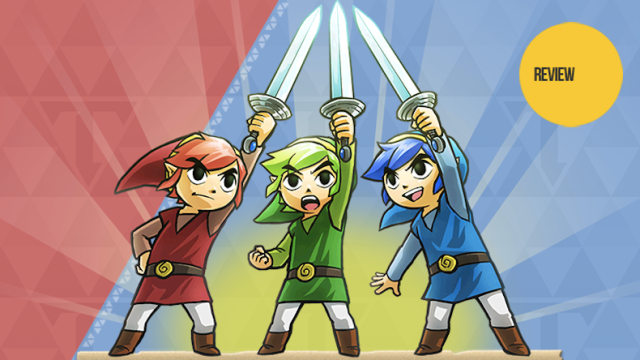
Comments
18 responses to “The Legend Of Zelda: Tri Force Heroes: The Kotaku Review”
All the game needs is the ability to add people who you’ve played with to friends. I got the game with a friend and we played last night and had a similar experience to what you described. Retards, lag and the occasional awesome person. If you could just add that person and play with them again.. It would be perfect!
Really wanted to play this with my girlfriend but with no option for only 2 players – sucks big balls.
At some point Nintendo forgot that it’s the 3rd parties who are supposed to put shovelware on their systems.
Didn’t they used to make ambitious, AAA games once?
What have we got this Christmas:
A Zelda that’s not really a Zelda
A Mario level maker that would be a cool addition to a real Mario game.
An Animal Crossing House designer missing the parts that make Animal Crossing good.
Half assed.
“To play with people you know but are not already 3DS friends with, you have to swap 3DS Friend Codes. Nintendo! ”
Because that’s so different from Steam or Xbox or whatever…
Except Steam makes it easy to see who you’ve previously played with and add them in game. Nintendo has never made adding friends easy.
That aside, anyone actually surprised that this turned out meh?
Specifically referring to the fact that on Steam and other platforms, if you want to play some games with friends, you still have to add them first.
Yeah, reviewers always bring up how annoying it is when you have to add friends on systems where you don’t need to share randomly allocated 12-digit codes. I’m sure the friend code thing had nothing to do with it.
I don’t understand the hate on friend codes anymore, on DS and Wii it sucked hard because every game had it’s own code, but that’s fixed now, Wii U uses a username and 3DS has a single identifying code, I’ve often found it quicker to get someone’s code and enter that than search for their current name on steam and scroll through until I find the right one.
Because you should just have an Nintendo account like you’ve had on the other consoles and all their companion machines for the past decade or more.
In the absence of being able to set that up, you should just be able to click on a player profile and then “request friend” without having to find or enter a code like you can on every other machine.
I don’t know exactly how it works in this game, but any process that involves manually finding your own friend code (I don’t know mine off the top of my head) and typing it in through the in game chat so that someone else can add you belongs back in the mid-90’s.
Press Home, Open Friends, your code is there.
As I pointed out already, The Wii U does let you add friends by their account name, so clearly Nintendo are trying.
As for adding randoms, the functionality does exist so I don’t know why it’s not in more games. In Monster Hunter 3U and 4U(Wii U and 3DS respectively) you can send and receive friend requests in-game.
Yes, it SHOULD do it in-game. It’s a multiplayer designed, 1st party Nintendo game and they can’t even do a half-assed job of helping people negotiate around their archaic systems. It’s 2015 and it’s just embarrassing.
The Xbox One backs every single save game onto the cloud seamlessly, I can log into my account on a mates machine and instantly his main menu looks exactly the same as my machine at home, I can download everything I already own and once I do, my saved games will be right there.
On my phone right now I can access the gameplay videos I’ve recorded and the screenshots I’ve taken, buy things from the XBL store (and have them downloaded on my machine when I get home), add and message my friends… not because I did anything fancy but because it all just works, I log into my Live account and it’s all there.
Nintendo have different schemes for different systems, it’s difficult to back things up, if you lose your portable system you might be f*cked, the WiiU has multiple BC modes through the Wii mode and the WiiU Store….. everything’s just as janky and as difficult as you could possible imagine.
They fell out of step when the internet became a thing and now they’re absolutely clueless.
@foggy
Seriously? You send a code to someone, they enter it into a device, you can now interact with them. I have to do the exact same thing with a friend’s phone number if I want to call them. Literally, I have to enter a 12 digit code into a device to interact with them. It’s a process I would never describe as janky or as difficult as I could possibly imagine.
You’ve got a decent point that Nintendo could do things better. I almost missed that point because of the obtuse hyperbole you’re throwing.
Nintendo are slow adopters, it’d be great if they caught up their network infrastructure, and at least made it more convenient for the lazy sods that can’t deal with phone numbers.
You’re right.
And SMS is the same as Morse code.
foggy is an appropriate name, because I didn’t say it was exactly the same.
Bloody hell, Jason, who the hell disliked Spirit Tracks?
This right here, is the entire review. If you enjoy games that are designed specifically to be played cooperatively, then this is a game you’ll likely enjoy.
and what is this? Name me a system where I can play with someone I already know without having to add them in some capacity. Wait, no, I can tell you: I ask a friend to come around and play on the same console with me, but then I would have to contact them somehow.
Nintendo’s handling of online play isn’t optimal, yet it certainly isn’t the bloody dark ages that some people cry about at every chance they get.
Is this just someone pissing about how they can’t have what they want when they want it? It sure does look like it.
Spirit Tracks to this date is still the only Zelda game that I’ve started and didn’t finish. So yeah, I guess I’m one of those who wasn’t that thrilled with Spirit Tracks.
I got up to the boss and quit there. I enjoyed the game, but the spin attack was extremely fickle =/
Well if I let both of my girlfriends meet eachother it wouldn’t end well for me 😉